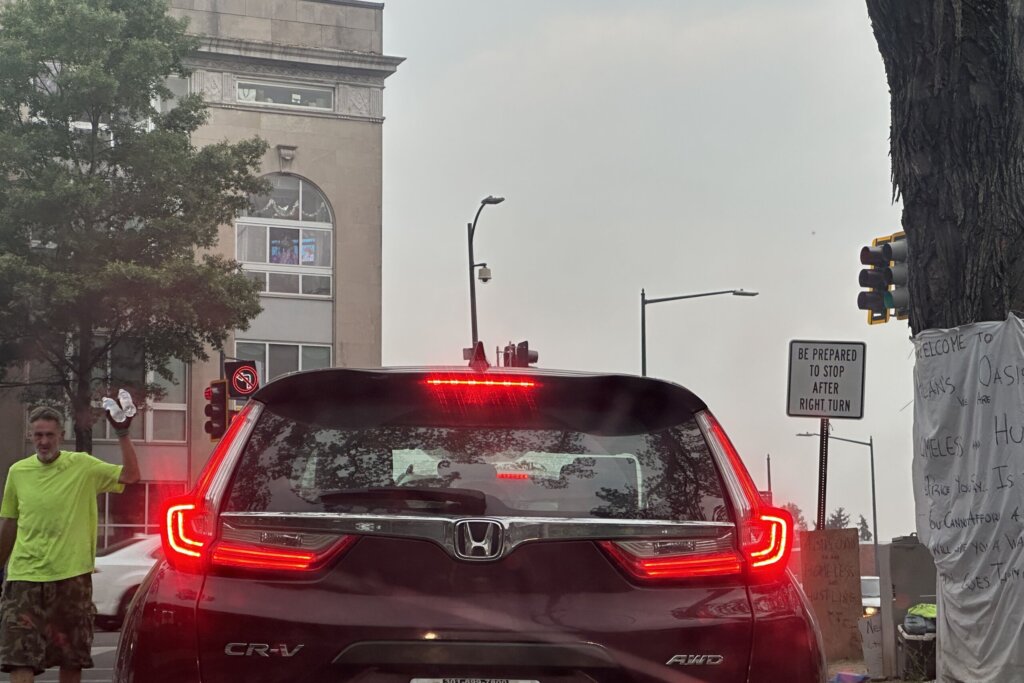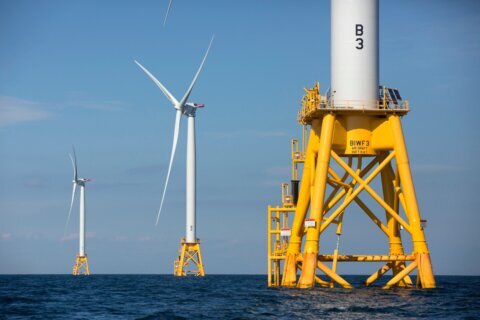
During the Wednesday morning commute through haze along Georgia Avenue in Northwest D.C., the region’s drivers smelled smoke in the air and kept on moving. Alan stayed put.
At the intersection of Missouri and Georgia Avenue, the “homeless and hustling” entrepreneur behind the self-named ‘Alan’s Oasis’ offered drivers water and cool beverages for car change while he stood in the smog.
“I’ll get you an ice cold water. Any cash will do,” Alan said on his way up the street.
Drivers passed him as they headed home, listening to the radio or a favorite podcast, but Alan remained on the street for hours. Aside from taking brief breaks for food or water, Alan spent hours walking up and down the line of cars, breathing in the smog that officials said no one should linger in.
Wearing a neon green shirt with his business’s name handwritten, he waved at passing drivers. Another lane began to pile up at the stop light just moments before he cleared his throat and grabbed a drink of water.
“Whew,” he said above the car noise. He fanned some air away from his nose while standing in the median just before handing a driver water.
With a few coins in hand, he said a quick “Thank you.” He cleared his throat again and continued walking the street.
Although the forest fires and related air quality didn’t particularly bother a ‘homeless and hustling’ Alan, the same may not be true for the rest of the region’s unhoused.
What plans did the District, Maryland and Virginia have to protect these highly sensitive populations?
Forest fires and DC smog
The latest air quality concerns pushed in from the north, as the wind brought fine particles from more than 150 fires near the province of Quebec, Canada, and some surrounding areas into Northern Virginia, D.C. and Maryland.
Though the blazes posed little local concern in mid May, harsh weather and shifting winds have continued to fuel the devastating fires. Effects from the smog stretched throughout the Northeast, turning the moon red for some viewers and creating a hazy barrier for drivers in the area.
Making matters worse: 7News First Alert Chief Meteorologist Veronica Johnson said our weather patterns have created what feels like fluctuation in the smog.
“There’s very light winds. So there’s really nothing to scour out this weather pattern,” Johnson told WTOP.
Officials with the EPA and AirNow.gov sent out warnings as jurisdictions issued Code Purple Alerts Thursday due to the air quality dipping to unhealthy for all populations, especially those with heart or lung disease, young and older folks. Local and state-level agencies echoed this message, encouraging people to stay indoors and avoid the unhealthy air.
Johnson called the air quality shift significant, adding that the D.C. area had double the number of Code Orange days this year compared to 2022. The area last hit a Code Red five years ago.
“At times, we briefly move into these short periods, where the air quality gets up to the level of Code Red, but that’s briefly,” and typically, “happens around the Fourth of July,” Johnson said.
Some of the common health problems among people experiencing homelessness — lung diseases, HIV and substance abuse issues — are among those illnesses present in sensitive groups.
And with the large number of fires continuing throughout Quebec and winds inevitably shifting again, Johnson said, “the door is likely to shut but won’t stay closed forever.”
“Those fires are not going to go out overnight. So, as soon as we get back into this northerly to northwesterly flow again, there will be times that we move back into this kind of rut of bad air quality around here,” Johnson said. “Do I think we’re going to have several back-to-back days again of Code Red? I think, at least, we could have a couple back-to-back days of Code Orange air quality.”
Guidance for residents and unhoused citizens
Like many city centers nationwide, a mixture of pollution and population density makes low air quality and higher-than-average unhoused populations all but unexpected.
DCHumanServ: NWS reports poor air quality today, which may be unhealthy for people with heart/lung disease, older adults, children/teens and residents experiencing homelessness.
If you see someone in need of shelter, call:
☎️ 202-399-7093 or 311;
… pic.twitter.com/xqFfYHmGPJ— The Community Partnership (@Partnershipdc) June 7, 2023
D.C. Mayor Muriel Bowser has made it a point to join many Democratic leaders in removing homeless encampments. The D.C. Council has moved to lower rent and work with executives to make housing more accessible across the city’s wards.
Bowser encouraged those who would need to shelter inside from the smoky air around the region to follow the area’s shelter protocol.
“Low-barrier shelters remain open 24 hours and are ready to receive residents who need relief from poor outdoor air quality. District and partner agency outreach teams are informing unsheltered residents to seek relief from poor outdoor air quality in shelters and service centers,” Bowser’s office said in a news release.
Maryland Gov. Wes Moore said the state’s health and environment departments were keeping an eye on the situation in Quebec and its impact on Marylanders.
Local shelters are also available in nearby Prince George’s and Montgomery counties in Maryland, as housing instability and the more immediate air quality issues continue in each jurisdiction. Other shelters in nearby Virginia, including Prince William, Fairfax, and Loudoun counties, have similar shelter available for those dealing with housing instability in the wake of this environmental incident.
“It’s a very serious matter in public health, when you have wildfires traveling such great distances and affecting people in the Northeast, mid-Atlantic (and Midwest),” said Dr. Clifford Bassett, an immunologist and asthma care specialist at New York University.
Speaking with WTOP about the broader effects ongoing wildfires could have, he highlighted that even healthier people might notice themselves struggling with a cough or clearing their throat.
“For most people, I think they’ll be fine. It’s a short-lived event of several days. Fortunately, it’s not an event we live with all the time,” Bassett said
He encouraged some familiar COVID-19 era decisions for all — wearing N95s, increasing the use of air filters, and he also advised limiting strenuous outdoor activities. But he highlighted that a doctor and knowledge of your physical health are essential.
“It affects people differently, but if you’re at high risk — and you know who you are — be aware,” Bassett said.
Planning for an environmental challenge
With a long-term housing crisis and potentially short-lived air quality public health issues in mind, climate change remains a constant. It’s been pointed out as the potential spark behind an ever-growing number of wildfires, including major brushfires in Australia and California.
Unseasonably dry weather lingering around the region and the Northeast has only worsened the problem, according to University of Maryland atmospheric and oceanic scientist Russell Dickerson.
“As the Earth gets warmer, the polar regions get warmer faster than mid-latitudes or tropical regions. When it’s warmer and drier, we’re probably going to see more forest fires,” he said.
Likewise, 7News First Alert Chief Meteorologist Veronica Johnson said it will be critical to make plans as environmental changes come around the bend.
“Everybody, everywhere needs to be prepared for a change in climate,” she said.
Johnson also emphasized the point that Dickerson and many other experts made — these climate changes add up in your day-to-day weather.
“The weather pattern that we are in, based on a lot of factors, put an exclamation behind it. If you’re dry, you’re that much drier. If you’re wet, you’re considerably wetter,” Johnson said.
With increased potential health hazards and research into the smoke underway, the region’s thousands of unhoused persons, known and unknown, remain in a potential 24/7 state of unhealthy air inhalation.
Some of these same unhoused citizens will have already spent months or years inhaling polluted air, which experts believe leads to serious adverse health outcomes.
So what changes are being made?
Ahead of the decreasing air quality and subsequent Code Purple, Virginia Gov. Glenn Youngkin fell under fire for supporting the state’s air pollution control board’s move to repeal the Regional Greenhouse Gas Initiative.
Calling the initiative a regressive tax on local families and businesses, he said the multistate carbon cap-and-trade program failed.
“While Virginians will see a lower energy bill in due time because we are withdrawing from RGGI and are one step closer with today’s vote, we need to ensure Virginia has a reliable, affordable, clean and growing supply of power by embracing an all-of-the-above energy plan that includes natural gas, nuclear, renewables and the exploration of emerging sources to satisfy the growing needs of Commonwealth residents and businesses,” Youngkin said.
The bill was among many efforts across Democratic and Republican jurisdictions to begin fighting the carbon emissions that scientists say contribute to global warming, worsening weather events and accelerating sea level rise.
Unhoused populations experiencing what the Metropolitan Washington Council of Governments (COG) deems “literal homelessness” in its annual census see significant exposure to the impact of climate change. In the case of the Quebec fire and lingering smog, these populations stand the potential of encountering the most severe impact of unyielding exposure to the potential results of climate change.
D.C. and Maryland have both put forward individualized plans for decreasing homelessness in the region, with both jurisdictions creating a plan to decrease carbon emissions or improve air quality significantly. Most recently, the District began a pilot program intended to take a constant look at air pollution, which disproportionately affect Black neighborhoods.
In late 2022, the COG deemed the area’s air quality had improved over the previous three years. A May air quality report from the American Lung Association painted a different picture, giving the region an F for general ozone smog. The area ranks just 26 from the bottom of the 200 metro areas surveyed in the report.








